If chicken feed is not stored correctly, it can become moldy, degrade its nutrients, and become unpalatable. Most importantly, moldy feed attracts pests.
That is why properly storing chicken feed and preventing spoilage is vital to avoid health issues, chicken productivity issues, loss of money, mold growth, and pests.
This article will dive deep into how to store chicken feed effectively to prevent loss of nutrients and spoilage.
Let’s Dive In.
Things That Mold Chicken Feed
What causes chicken feed to mold and make it unsuitable for chickens?
Here are the most common factors that ruin your chicken feeds:
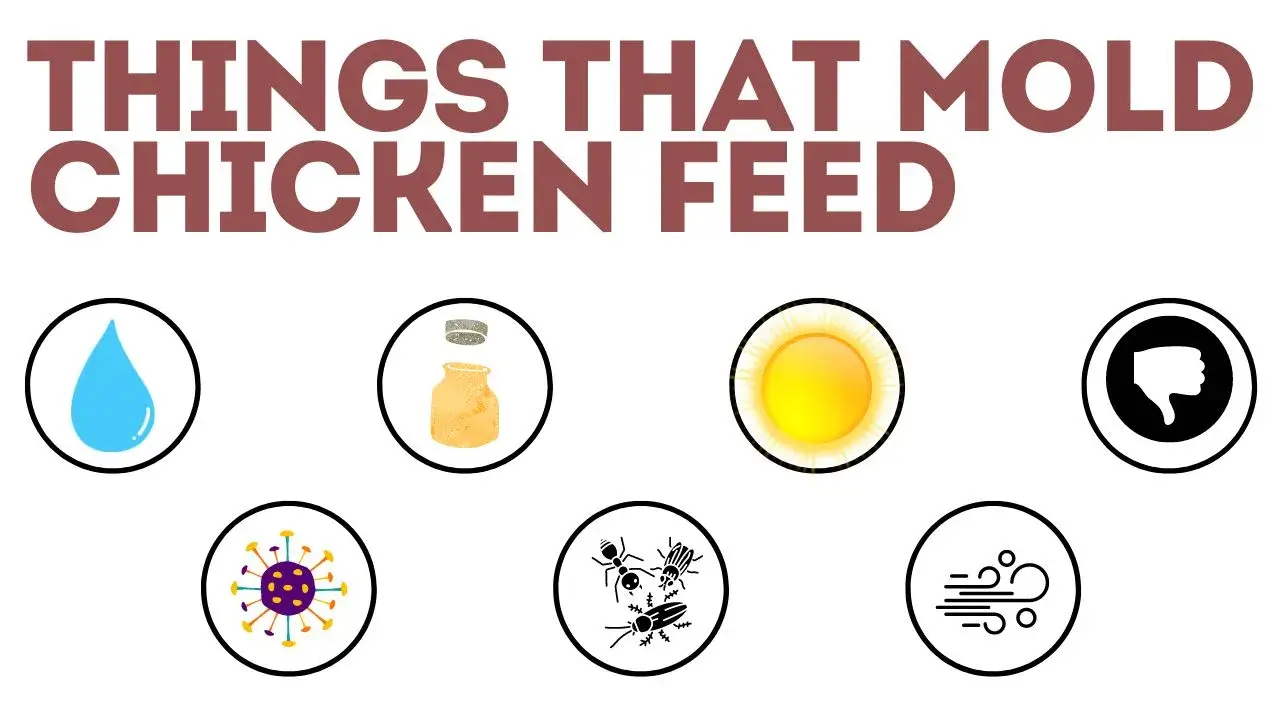
-
Moisture
If you put feed directly on the floor or don’t keep it dry in moisture conditions, there is a chance that your chicken feed will become moldy and spoilage by moisture. And moldy feed contains toxins that cause many health problems and even death.
-
Bad Storage Conditions
If you don’t correctly store chicken feed, specifically in warm areas, this can also promote spoilage, which can cause health problems for chickens and attract pests.
-
Excessive Light and Heat
Overexposure to light (sunlight) can degrade the quality of chicken feed, contribute to the oxidation of fats, and reduce its shelf life.
Also, excessive heat can break down nutrients in feed, reducing its nutritional value and promoting the growth of molds and bacteria. Heat causes the chicken feed to spoil more quickly.
-
Poor Feed Quality
If the feed you buy is low quality, it is easy to spoil, and if it has been stored for too long, it is also more prone to mold.
-
Contamination
The feed can become contaminated during handling, processing, or offering in a dusty feeder, leading to mold, especially if these practices are unhygienic.
-
Available of Pests
Rats, insects, and wild birds carry disease; if they come in contact with chicken feed, the feed may be contaminated with disease microorganisms. Try to prevent rodents and pests from chicken coop and feed.
-
Poor Ventilation
When there is no adequate ventilation or air in areas where chicken feed is stored, mold and spoilage can occur.
How To Store Chicken Feed
Before discussing “how to properly store chicken feed,” you must first determine whether your chicken feed is normal and okay or spoiled and moldy.
To know whether your chicken feed is okay or moldy, just observe and experience the following things:
- Off Odors
- Discoloration
- Mold or Fungi
- Changes in Texture
- Clumping or Caking
- Presence of Insects or Pest Infestation
If your chicken feed is in good condition, that’s okay, but if it is moldy or spoiled, you must follow the feed-storing practices below.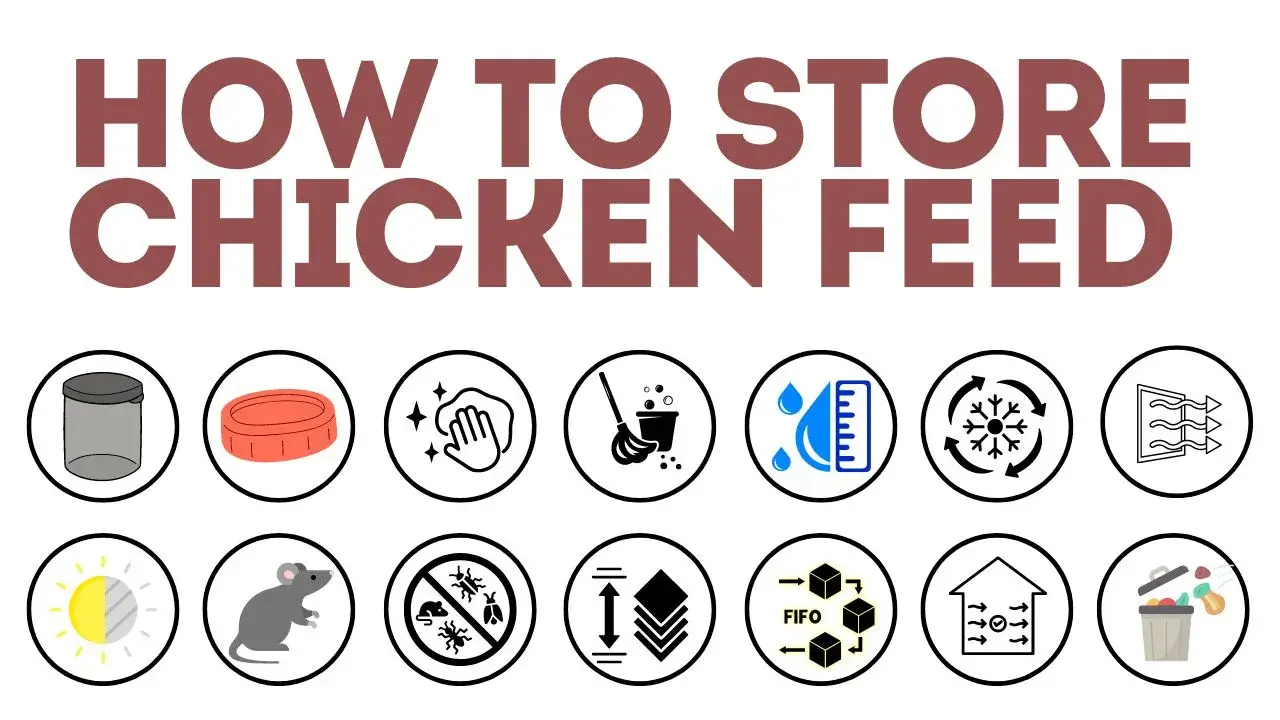
-
Right Container is Essential
Choose the right container for storing chicken feed, such as a metal container, plastic container, or Food-Grade Storage Bin with tight-fitting lids to protect the feed.
-
Container Should Have Airtight Lids/Sealing
Ensure all feed bags are tightly sealed, and containers have tight-fitting lids to prevent exposure to air, moisture, and pests.
-
Keep Containers Clean
To prevent the risk of affecting feed, the container should be appropriately cleaned from dirt and water and dried before storing feed. You can use mild detergent for cleaning.
-
Keep the Area Clean
The area where you store chicken feed should be clean and neat; regularly cleaning the surrounding area will prevent contamination, deter pests, and maintain hygiene.
-
Balance Temperature and Humidity
High temperatures and humidity can accelerate spoilage and mold growth, and the best temperature in storing areas is below 75°F (24°C) with a humidity level under 50%.
-
Store in a Cool, Dry Place
Ensure that the feed is kept in a cool and dry area away from direct sunlight and high temperatures. Extreme exposure to heat and light can accelerate spoilage.
-
Proper Ventilation is Crucial
Proper ventilation is vital in the storage area to prevent moisture, which causes mold growth. However, excessive airflow should be avoided, as this could accelerate feed oxidation.
-
Managing Light Exposure
Prolonged exposure to light can degrade the nutrients in chicken feed. Store feed in nontransparent containers or a dark area to protect it from direct sunlight.
-
Feed Should No Direct Access to Other
Keep chicken feed away from other birds, pets, and animals to prevent the risk of contamination and spoilage.
-
Pest Free Environment
Ensure the storage area is free from pests (rats, insects), use pesticides or rodenticides, and clean spilled feed to keep them away as they can carry harmful pathogens.
-
Keep it Elevated From the Ground
Store feed off the ground to prevent moisture from the floor, pests, and other animals. Elevate the containers with pallets or shelves.
-
Use FIFO (First In, First Out)
Practice FIFO to ensure older feed is used first. This helps maintain freshness and ensures chickens receive feed within their optimal storage period.
-
Always Stored Feed Indoors
Do not store chicken feed in an open area. It can be exposed to rainwater, other animals, high temperatures, and prolonged exposure to light. Always store feed indoors.
-
Remove Any Spoiled Feed
Ensure that any moldy or spoiled chicken feed is removed immediately from the storage containers or area, as they can spoil everything around them.
Best Way To Store Chicken Feed
Let’s discuss some of the best ways to store chicken feed correctly. We will try to discuss the DIY method, the cost-effective method, the storage containers, and prevention strategies.
Let’s explore this:
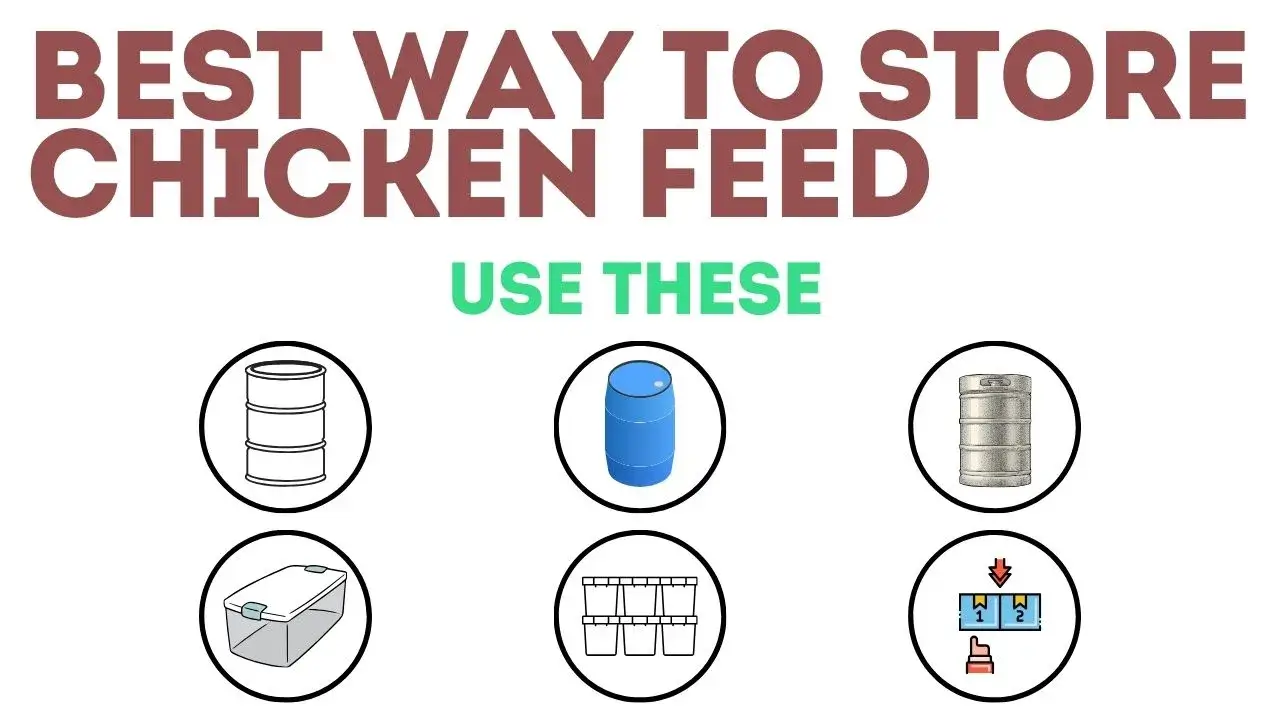
-
Food-Safe Steel Barrels
They are nonreactive and made of porcelain or food-safe paint. These barrels have nonreactive liners that protect feed from reacting with the steel.
-
Plastic Barrels
Plastic or Poly barrels are a lightweight, good choice as they are non-reactive, but the minus point is they don’t resist chewing by rodents and don’t resist too much light, such as meta.
-
Metal Containers
Metal containers provide excellent protection against pests and environmental factors. They are ideal for long-term storage, but they react with feed.
If you choose to use steel containers, it’s best to keep bagged feeds inside their original bags rather than pouring them directly into the steel container.
-
Plastic Containers
Plastic containers are affordable, lightweight, and provide a good seal against moisture and pests. However, they should be high-quality and food-grade.
-
Food-Grade Storage Bins
Food-grade storage bins are designed to store items, ensuring the feed remains safe and uncontaminated; these bins are airtight, providing protection against moisture and pests.
-
Use FIFO (First In, First Out)
Use the FIFO technique to ensure older feed is used first. This helps maintain freshness and ensures chickens receive feed within their optimal storage period.
| Tip:
Natural repellents such as peppermint oil can effectively deter pests without using harmful chemicals. Apply them around the storage area to enhance protection against pests. |
DIY Ways to Store Chicken Feed
- Trash Can: Use clean, neat, food-grade trash cans with tight-fitting lids. These can hold large quantities of feed and are relatively inexpensive.
- Sealable Bags: If you have a small amount of feed, use sealable plastic bags. Store them in a cool, dry place and tightly seal them to prevent pests and moisture.
- Use Containers: If you have plastic and metal containers, like old barrels or storage bins with lids, clean them properly and pour the feed you want to store into them.
- Feed Bins: Create your own wooden or metal feed bins with tight lids. These can be customized in size to fit your storage needs.
- Pallet Storage: Place feed bags on pallets inside a shed or barn. This will prevent the feed from falling to the ground, minimizing moisture absorption and pests getting into the feed.
You can use any containers or other storage containers to keep your chicken feed safe from spillage and mold, but they should be clean and safe.
| Note:
Ensure all storage containers used for chicken feed are sealed tightly, and keep the surrounding area clean to prevent rodents, moisture, or other risks. Additionally, label all containers clearly with the type of feed you store in and the purchase or expiration date to ensure proper rotation and freshness. |
How to Store Chicken Feed in Different Climates
Chicken feed should not be kept in the same area in a different climate; it should be removed from the area where it is at risk of molding or spoilage.
Here is a brief discussion about storing chicken feed in different climates:
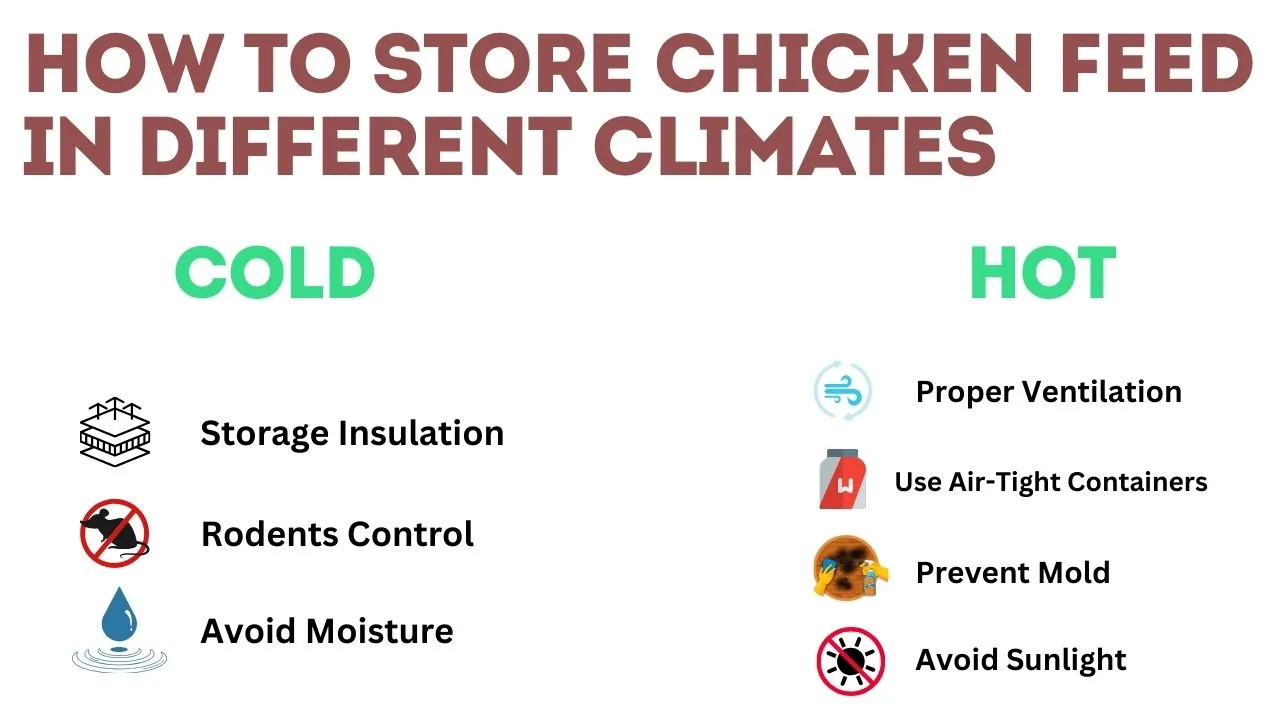
Storing Chicken Feed in Cold Climates:
-
Storage Insulation
Try to insulate the storage area. Insulating helps maintain a stable temperature in cold climates, preventing freezing, which can alter the texture and nutritional value of feed.
-
Controlling Rodents
Cold weather causes rodents to go indoors, and you may also experience this. Provide them with rodent-proof containers and regularly monitor for signs of pests.
-
Avoiding Moisture
Cold climates can cause condensation, which leads to moisture. Cold temperatures also freeze chicken feed, especially fermented chicken feed, so use dehumidifiers to ensure the feed is dry.
Storing Chicken Feed in Hot and Humid Climates:
-
Proper Ventilation
Proper ventilation is crucial in hot and humid climates to prevent mold growth and spoilage. Use storage containers with ventilation or store feed in a well-ventilated area.
-
Use Air-Tight Containers
Use air-tight containers or bins to prevent excessive heat and seal the feed from moisture in the air.
-
Preventing Mold and Pest Infestation
High humidity levels can lead to mold and pest infestations. Use desiccant and pest repellents to keep feed dry and pest-free.
-
Avoid Sunlight
Light also affects the quality of feed. That is why chicken feed should be stored away from direct sunlight, as UV rays can degrade nutrients and fats in the feed.
How Long Can Chicken Feed Be Store
Okay, we understand how to store chicken feed, but there is another question: How long does chicken feed last, and how should it be keep to use for long time?
The longevity of chicken feed varies depending on the type and how it’s stored. For example, even if feed is supposed to last for five months, if it’s stored poorly, it might not last that long. Improper storage can also reduce its shelf life.
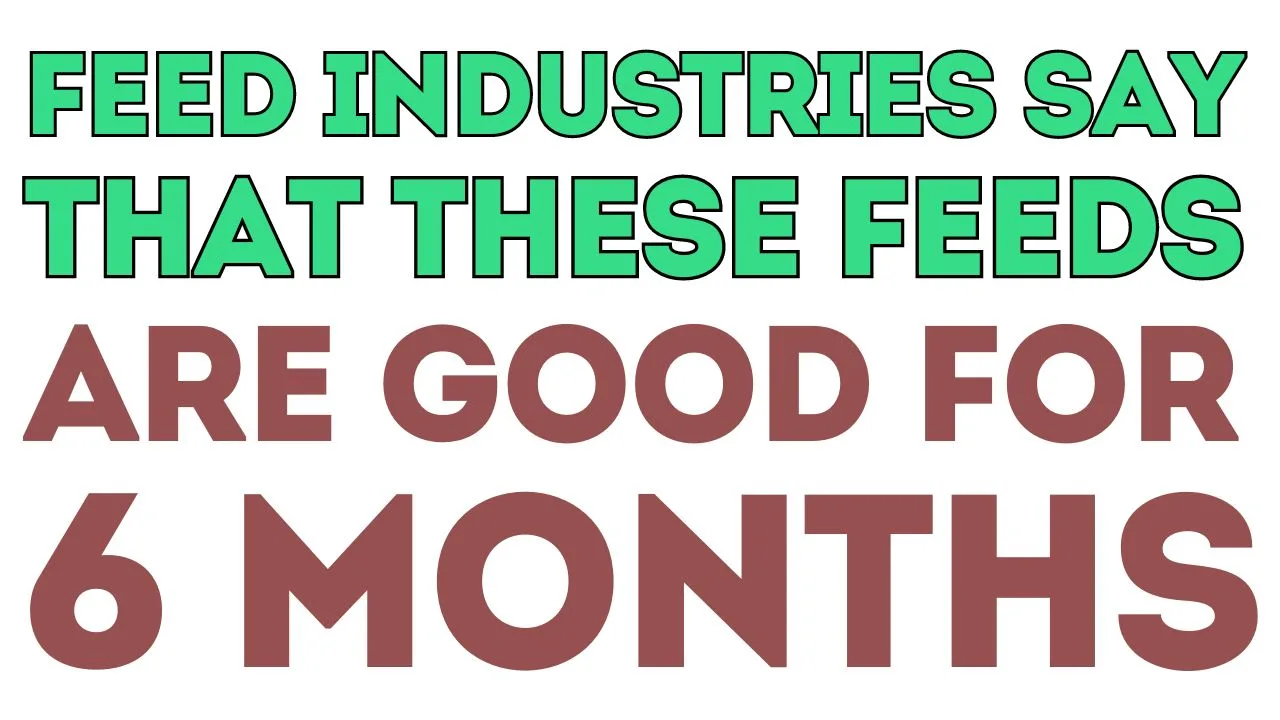
Okay, what is the shelf life of different chicken feeds? First, you can’t usually see the date on the feed bag, but the feed companies and industry say these feeds are good for six months from the time you buy them.
Mash chicken feed is prone to become moldy; this food’s integrity can be ruin if it’s wet for more than a day, and pellet chicken feed lasts the longest with proper storage.
Pelleted Chicken Feed lasts up to six months when stored properly. Crumbled Chicken Feed usually lasts about three months under proper storage conditions, and Mashed Chicken Feed typically has a shelf life of up to two months if stored correctly.
Other types of chicken feed, like Shell Grit, can often be stored for a longer time, usually around a year or more, when kept in a dry, cool place and protected from moisture and pests.
However, following good storage practices is essential to keep feed fresh and safe for your chickens.
Ending
If you store chicken feed without proper practices, you will face issues like spoilage, loss of money, health problems in chickens, and many others. That is why it is important to store chicken feed properly.
Follow our best practices and ways to store chicken feed to maintain feed quality, prevent spoilage, and protect against pests. In the comment section, let us know if you have any questions about this topic.
I hope this article helps you in storing chicken feed properly!
Commonly Asked Questions
Can I store chicken feed in a metal barrel?
Yes, you can safely store chicken feed in a metal barrel. These barrels have nonreactive liners that protect feed from reacting with the steel.
How do you keep ants out of chicken feed?
To keep chicken feed away from ants, use an airtight container, keep the area clean, use baits or barriers, and sprinkle diatomaceous earth on the ground.
How can bees be keep away from the chicken feed?
You can use feeders with small openings to keep bees away from chicken feed. These openings allow only chickens to access the feed.
Keep the area clean—plant bee-repelling plants around the chicken coop. Use essential oils such as citronella or lemongrass, and away water source from the feed.
How do you store fermented chicken feed?
A cellar or ban should be use for storing fermented chicken feed. It’s best to use airtight containers to prevent unwanted pests and odors. Make sure to label the containers with the date of fermentation to keep track of freshness.
Additionally, it’s essential to keep the feed off the ground to avoid moisture and contamination.
How to store chicken feed in a coop?
To store chicken feed in a coop, it’s essential to keep it in a secure, rodent-proof container to prevent contamination and spoilage. Use metal or plastic bins with tight-fitting lids to keep the feed dry and safe from pests.
Elevating the containers off the ground can help prevent pest access. Regularly inspect the containers for signs of damage and moisture, and always discard any moldy or spoiled feed.
Hello! I’m Ibrahim, the owner and writer of this blog. I run a chicken farm with 160 chickens, and I’ve gained a lot of knowledge about raising and caring for them. Now, I want to share my insights and experiences with you to help you in chicken keeping.

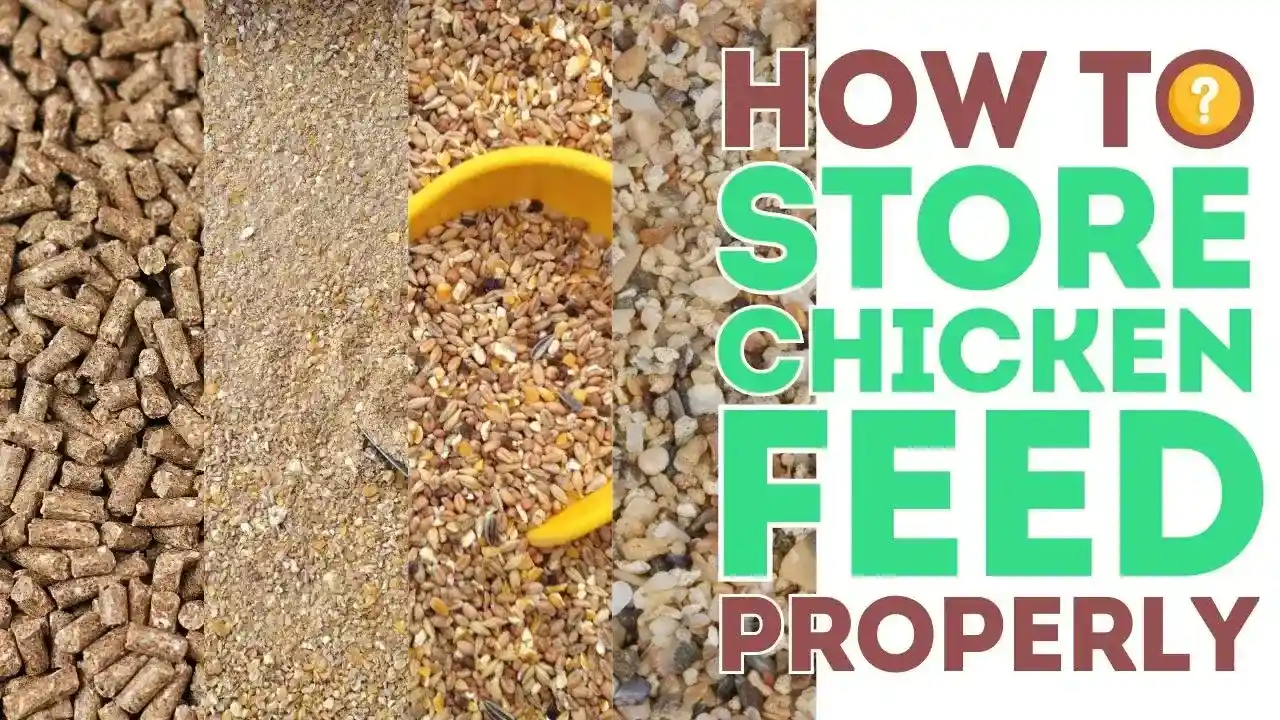
Hey people!!!!!
Good mood and good luck to everyone!!!!!